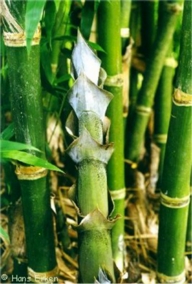

Common Names: Spineless
Indian Bamboo, Calcutta Cane
Genus: Bambusa
Species: tulda

The Bambusa tulda can be found in the biome of the Southeast Asian rainforest. It often grows as an undergrowth scattered or in patches in the forest. It does very well in a moist environment with a lot of rainfall. It likes temperatures between 40 degrees Fahrenheit and 100 degrees Fahrenheit. Rainforests get around 100 inches of rain per year. Rainforests are found mainly around the equator. They hold many varieties of plants and animals. The vegetation in rainforests grows in layers. Some of the layers get sunlight, but the bottom layers get little or no sunlight.
This particular bamboo can grow anywhere between 40 feet and 80 feet in height. It is approximately 3 inches in diameter at maturity. This bamboo has dark green straight stalky culms, which are the stems. The leaves are long and narrow and green in color. They grow alternately on opposing sides of the stem, in two rows. Usually the blades fall off when the leaves have matured. This leaves a sheath like base. Bamboo is a perennial plant. Believe it or not, bamboo is not a tree or a shrub, it is a grass. It is the largest grass. It is very fast growing. In two to three months it is full grown. The culms or stems never get thicker after they are full grown. They only flower once in their lifetime and die after they bloom. No matter where they grow, different plants of the same species flower at the same time. New plants grow from the seeds that resemble rice kernels. This species life span is 25 to 40 years.
Bambusa tulda is important to its environment. It can reduce soil erosion. It sucks up water from heavy rains that might cause flooding. It also provides shelter for many animals. A rainforest has plenty of water for this plant to grow. It physically adapts to its environment by growing tall fast so it gets a lot of rain and sunlight.
Bambusa tulda is mainly used by the Indian paper pulping industry. It is also used for furniture, making baskets and reinforcing concrete. This type of bamboo is used to make a sacred flute called the "Eloo". It is also used for fishing rods. It is one of the most useful species of bambusa.
Rainforests are disappearing at the rate of 80 acres per minute, which is a little over 1 acre per second. Bambusa tulda is not on the endangered species list. It is native to India, Burma, Bangladesh, Myanmar and Thailand. Although there is no formal conservation plan, some of the local people are trying to conserve it in their area. They do this in their homestead and settled forest areas by planting it and being cautious about how much they harvest.
By Zachary C. 2002
Bibliography:
Photo Credit: © Hans Erken
Cusack, Chris, Margaret & Victor; Stewart, Deirdre. "Bamboo World - Species Reference List". http://www.bambooworld.com/au/ pages/SpeciesRef.html. (Nov. 5, 2001).
Dransfield, John; Dransfield, Soejatmi; Widjaja, Elizabeth & Renuka, C. "Priority Species of Bamboo and Rattan". 1998. http://www.inbar./int/publication/txt/INBAR_Technical_Report_N 001.htm. (Nov. 4, 2001).
Ecocyber. "Bamboos". 1998-2001. http://www.earthcare.com.au/bamboo.htm. (Nov. 5, 2001).
Hadly, Jason; Tiller, Leisa; Vaughan, Sara. "Tropical Rainforest Biome". http://ths.sps.lane.edu/biomes/rain3/rain3.html. (Jan. 20, 2002).
Munro. "Endangered Bamboo Species". http://endangeredspecies.com/endang- ered.htm. (Nov. 6, 2001).
Porcher, Michel H. "Sorting Bambusa Names". 1997-2001. http://gmr.landfood.unimelb.edu.au/Plantnames/Sorting/Bambusa. htm. (Nov. 5, 2001).
The McGraw-Hill Companies. "Botany Global Issues Map". 2000. http://www.mhhe.com/biosci/pae/botany/botany_map/articles_38. html. (Oct. 31, 2001).
W, S.L. "Tropical Broadleaf Evergreen Forest: The Rainforest". October 13, 1996. http://www.runet.edu/~swoodwar/CLASSES/GEOG235/biomes/rain forest/ rainfrst. html. (Jan. 20, 2002).